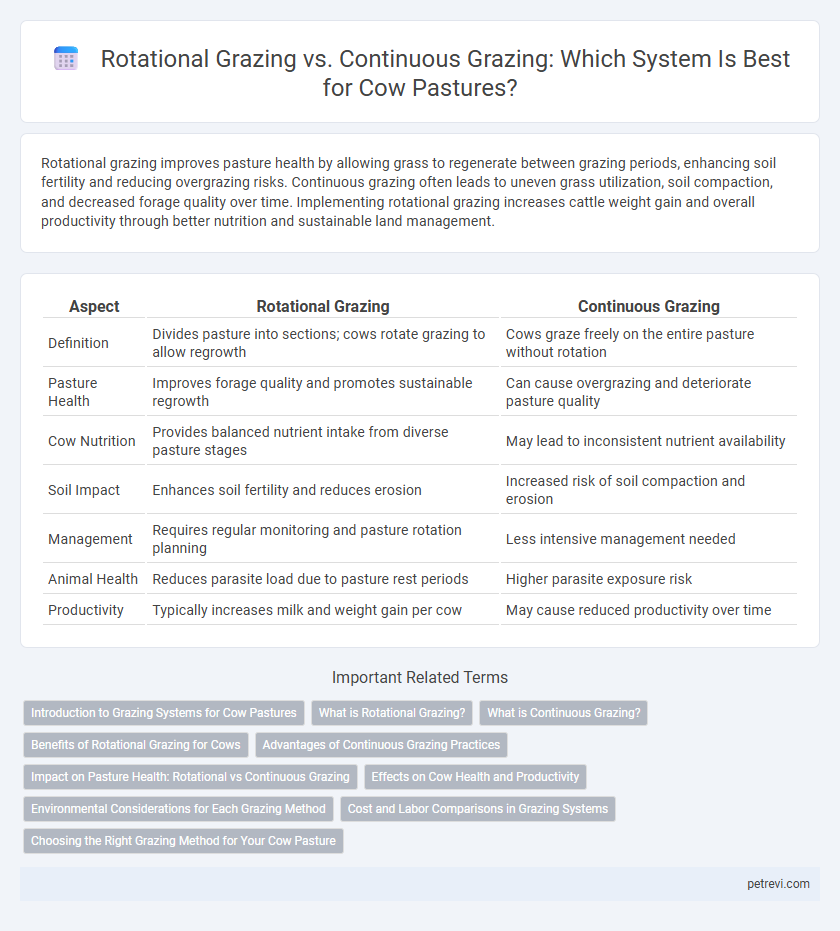Rotational grazing improves pasture health by allowing grass to regenerate between grazing periods, enhancing soil fertility and reducing overgrazing risks. Continuous grazing often leads to uneven grass utilization, soil compaction, and decreased forage quality over time. Implementing rotational grazing increases cattle weight gain and overall productivity through better nutrition and sustainable land management.
Table of Comparison
| Aspect | Rotational Grazing | Continuous Grazing |
|---|---|---|
| Definition | Divides pasture into sections; cows rotate grazing to allow regrowth | Cows graze freely on the entire pasture without rotation |
| Pasture Health | Improves forage quality and promotes sustainable regrowth | Can cause overgrazing and deteriorate pasture quality |
| Cow Nutrition | Provides balanced nutrient intake from diverse pasture stages | May lead to inconsistent nutrient availability |
| Soil Impact | Enhances soil fertility and reduces erosion | Increased risk of soil compaction and erosion |
| Management | Requires regular monitoring and pasture rotation planning | Less intensive management needed |
| Animal Health | Reduces parasite load due to pasture rest periods | Higher parasite exposure risk |
| Productivity | Typically increases milk and weight gain per cow | May cause reduced productivity over time |
Introduction to Grazing Systems for Cow Pastures
Rotational grazing divides pasture into multiple paddocks, allowing cows to graze one area while others recover, promoting healthier forage growth and improved soil fertility. Continuous grazing permits cows to graze the entire pasture without rest periods, often leading to overgrazing and soil degradation. Implementing a strategic grazing system enhances pasture sustainability and optimizes cattle nutrition.
What is Rotational Grazing?
Rotational grazing is a pasture management system where cows are moved between multiple grazing paddocks to allow forage plants time to recover, promoting healthier pasture growth and improved soil health. This method increases forage utilization efficiency, enhances nutrient recycling, and reduces overgrazing compared to continuous grazing, where cows remain on the same pasture. Studies show rotational grazing can boost livestock weight gain and pasture sustainability by maintaining optimal forage availability and diversity.
What is Continuous Grazing?
Continuous grazing is a pasture management strategy where cows have unrestricted access to the same grazing area throughout the grazing season, allowing them to feed continuously on available forage. This approach often leads to overgrazing, soil compaction, and reduced pasture productivity due to uneven forage utilization and insufficient recovery time for the grass. In contrast to rotational grazing, continuous grazing can diminish pasture health and decrease overall cow nutrition efficiency.
Benefits of Rotational Grazing for Cows
Rotational grazing improves pasture health and increases forage availability, providing cows with fresher, more nutritious feed that enhances milk production and weight gain. This method reduces parasite load and soil compaction, promoting better cow health and reducing veterinary costs. By mimicking natural grazing patterns, rotational grazing supports sustainable land management and increases overall herd productivity.
Advantages of Continuous Grazing Practices
Continuous grazing allows cows unrestricted access to pasture, promoting natural foraging behavior and minimizing stress. This method requires less labor and management complexity compared to rotational grazing, reducing operational costs for farmers. Continuous grazing also supports consistent nutrient intake for cows, enhancing steady milk production and weight gain.
Impact on Pasture Health: Rotational vs Continuous Grazing
Rotational grazing significantly improves pasture health by allowing grass to recover between grazing periods, which promotes deeper root growth and increases soil organic matter. Continuous grazing often leads to overgrazing, soil compaction, and reduced plant diversity, ultimately degrading pasture quality. Studies show rotational grazing can boost biomass by up to 30% while enhancing nutrient cycling and reducing erosion rates compared to continuous grazing.
Effects on Cow Health and Productivity
Rotational grazing significantly improves cow health by reducing parasite loads and promoting better forage quality, leading to increased milk production and weight gain. Continuous grazing often results in overgrazed pastures, causing nutritional deficiencies and higher stress levels in cows, which negatively impact overall productivity. Implementing rotational grazing systems enhances rumen function and immune response, thereby supporting sustainable livestock management and economic gains.
Environmental Considerations for Each Grazing Method
Rotational grazing enhances pasture health by allowing grass recovery, reducing soil erosion, and improving carbon sequestration compared to continuous grazing, which often leads to overgrazing and soil degradation. This method promotes biodiversity by maintaining diverse plant species and providing better habitat conditions for wildlife, whereas continuous grazing typically results in reduced plant variety and increased weed invasion. Efficient nutrient cycling under rotational grazing minimizes nutrient runoff, protecting waterways from contamination often associated with the persistent grazing pressure of continuous systems.
Cost and Labor Comparisons in Grazing Systems
Rotational grazing systems typically require higher initial investment and labor due to frequent paddock shifts, fence installation, and water supply management, but they enhance pasture productivity and reduce feed costs over time. Continuous grazing demands less labor and lower upfront costs but often leads to overgrazed pastures, resulting in decreased forage quality and increased supplemental feeding expenses. Evaluating cost-efficiency reveals that rotational grazing offers long-term economic benefits despite increased labor, optimizing pasture utilization and cow health.
Choosing the Right Grazing Method for Your Cow Pasture
Rotational grazing improves pasture productivity and cow health by allowing grass to recover between grazing periods, leading to higher forage quality and increased weight gain. Continuous grazing may result in overgrazed areas with reduced forage availability and soil erosion, negatively impacting pasture sustainability and cow nutrition. Selecting rotational grazing optimizes land use efficiency while supporting long-term pasture vitality and cattle performance.
Rotational Grazing vs Continuous Grazing for Cow Pasture Infographic

 petrevi.com
petrevi.com